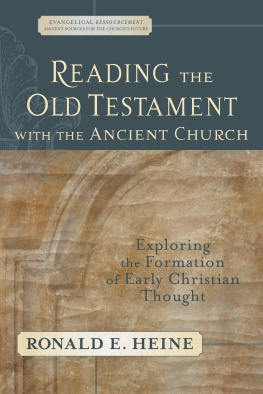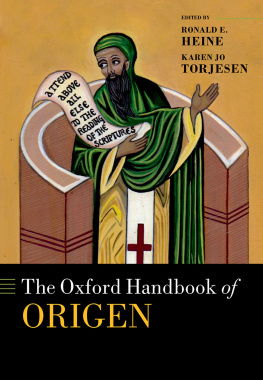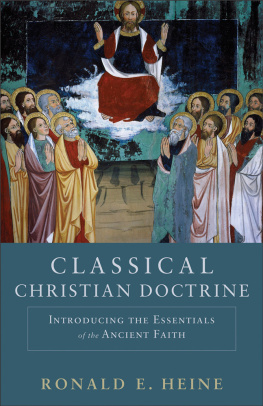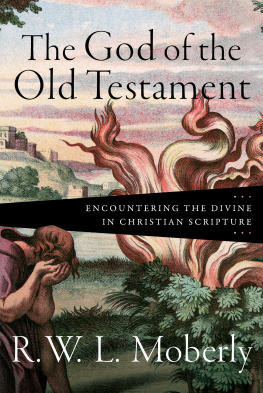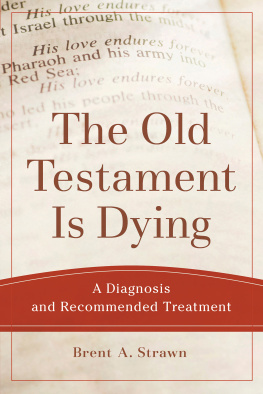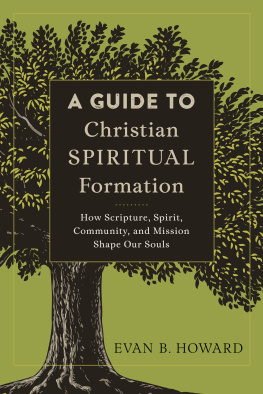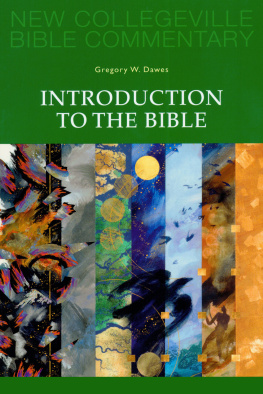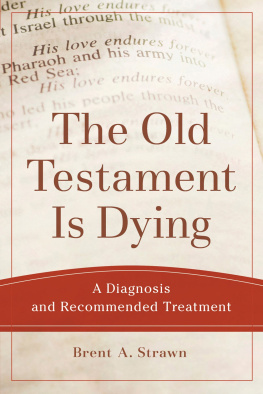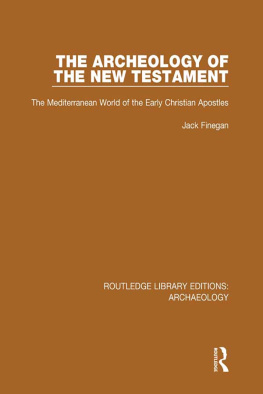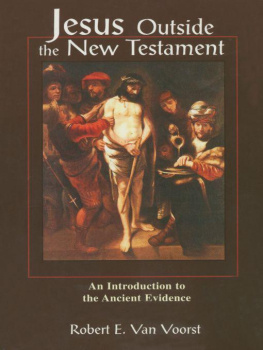EVANGELICAL RESSOURCEMENT
ANCIENT SOURCES FOR THE CHURCH S FUTURE
D. H. Williams, series editor
The Evangelical Ressourcement series is designed to address the ways in which Christians may draw upon the thought and life of the early church to respond to the challenges facing todays church.
2007 by Ronald E. Heine
Published by Baker Academic
a division of Baker Publishing Group
P.O. Box 6287, Grand Rapids, MI 49516-6287
www.bakeracademic.com
Ebook edition created 2010
Ebook corrections 04.19.2016 (VBN), 05.14.2019
All rights reserved. No part of this publication may be reproduced, stored in a retrieval system, or transmitted in any form or by any meansfor example, electronic, photocopy, recordingwithout the prior written permission of the publisher. The only exception is brief quotations in printed reviews.
Library of Congress Cataloging-in-Publication Data is on file at the Library of Congress, Washington, DC.
ISBN 978-1-4412-0153-9
Scripture quotations labeled NRSV are from the New Revised Standard Version of the Bible, copyright 1989 National Council of the Churches of Christ in the United States of America. Used by permission. All rights reserved.
Scripture quotations labeled NIV 1984 are from the Holy Bible, New International Version. NIV. Copyright 1973, 1978, 1984 by Biblica, Inc. Used by permission of Zondervan. All rights reserved wor ldwide. www.zondervan.com
To the memory of my friend and former colleague
Prof. Dr. Otto Betz,
who was a master in using the Old Testament
to interpret the New
You are not able to enter into the Holy Scriptures
without a guide to show you the way.
Jerome, Epistle 53.6
CONTENTS
Introduction
6. Living in the Text
English Sources for Exegetical and Homiletical Works
of the Church Fathers
Modern Sources
| ABD | Anchor Bible Dictionary |
| ACW | Ancient Christian Writers |
| ANF | The Ante-Nicene Fathers |
| BETL | Bibliotheca Ephemeridum Theologicarum Lovaniensium |
| CCSL | Corpus Christianorum: Series Latina |
| FC | The Fathers of the Church |
| JECS | Journal of Early Christian Studies |
| JTS | The Journal of Theological Studies |
| LXX | Septuagint |
| NIV | New International Version |
| NPNF | The Nicene and Post-Nicene Fathers of the Christian Church, 2 series |
| NRSV | New Revised Standard Version |
| OECS | Oxford Early Christian Studies |
| PG | Migne, Patrologia Graeca |
| WSA | The Works of Saint Augustine: A Translation for the 21st Century, 3 parts |
| ZAC/JAC | Zeitschrift fr antikes Christentum/Journal of Ancient Christianity |
Ancient Christian and Jewish Sources
| ComMt ser. | Origenes Werke 11 (Die griechischen christlichen Schriftsteller), ed. E. Klostermann, E. Benz, and U. Treu |
| Exp. Ps | Augustine, Expositions of the Psalms |
For the other commentary and homiletical literature of the church fathers the following abbreviation system has been used. Com (= Commentaryon) or Hom (= Homilies on) is joined to a standard abbreviation of the biblical book, so that ComJn means Commentary on John, and HomEx means Homilies on Exodus, and so on.
| 4Q174 | Florilegium, or Midrash on the Last Days |
| 4Q175 | Testimonia, or Messianic Anthology |
| 4Q252 | Commentary on Genesis A |
| 4Q377 | A Moses Apocryphonc |
| 4Q521 | Messianic Apocalypse |
| 11Q5 | Apocryphal Psalms (1) |
T HE EVANGELICAL CHURCH is in danger of having a cut-flower faith. Its message of Jesus is largely severed from its roots in the Old Testament Scriptures. This is more the result of neglect than of intention. I am part of an evangelical tradition that began in the nineteenth century with the dream of restoring the church of the New Testament. The leaders of this tradition placed a great emphasis on the New Testament but neglected the Old. They failed to perceive that the Old Testament was the Bible of the church of the New Testament. Many evangelical communions make that same error. None of them, including my own, would claim that the Old Testament is not Scripture or that it should not be a part of the Christian canon. Its vital connection with the churchs gospel of Jesus Christ, however, is rarely understood today and even less frequently taught in the church.
This book examines how the church fathers, the leaders and teachers of the church in the first four centuries, used the Old Testament as Christian Scripture. It is not a book about the methods of interpretation used by the fathers, at least not in the usual sense of such studies. Frances M. Young is correct, I believe, when she discounts the adequacy of the approaches customarily taken in the study of the church fathers interpretation of the Bible. Their interpretative methods will, of course, sometimes be an unavoidable part of the discussion but the purpose of my study does not lie in this arena. I am interested in examining the central role that the Old Testament played in the formation of Christian thinking and life in the early centuries of the church. I hope to capture the way the fathers regarded the Old Testament and some of the uses to which they put it.
While it was natural that the earliest Christians should take up the Jewish Scriptures as their Scriptures, it was also problematic. How should they, as Christians, relate to the demands of the Jewish law? How could they understand Isaiah 53 to speak of the sufferings of Jesus of Nazareth when the leaders of the synagogue understood it to refer to the sufferings of the Jewish people? Does Isaiah 7:14 refer to a virgin giving birth as the Christians held, or to a young woman giving birth as the Jews argued? These were the kinds of questions forced on the early Christians as they took up the Jewish Scriptures as their Bible.
The Old Testament provided the glasses through which the early Christians looked at Jesus of Nazareth. The doctrines they put forth regarding him and the significance of his life for humanity depend on Old Testament texts that they read in relation to him. There would have been no Christianity without the Old Testament. When the books that make up our New Testament were eventually written and elevated to the status of Scripture alongside the books of the Old Testament, the two testaments together formed the Christian Bible. The Old Testament was as much Christian Scripture as the New and was used in the same way as the New in Christian teaching and preaching. This attitude of the fathers concerning the two testaments continued through the period of the Protestant Reformation. Luther and Calvin considered both testaments to be vital for Christian teaching. It was in the post-Enlightenment period that the New Testament began to be orphaned from the Old. This process reached its climax in the critical studies of the late nineteenth and early twentieth centuries. The end result of this process has been an ambivalence about the use of the Old Testament in the church.
Various organizations and individuals contributed to the writing of this book. Chapters 2 and 3 began as lectures I delivered for the C. H. Phillips Lectures at Puget Sound Christian College in 2002. It was this series of lectures that provided the impetus for me to begin developing the seed idea that had lain dormant in my mind for several years. Chapter 2 was also presented to the Kolloquium fr Graduierte at the Eberhard Karls Universitt in Tbingen, Germany, in 2004.
Next page
